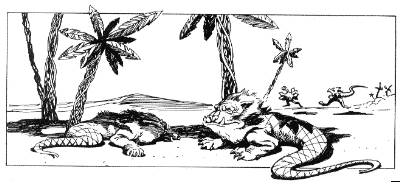
During an adventure, creatures as well as intelligent alien races may be encountered. Because there is such a great variety of creatures on one planet and so many different worlds to adventure on. it is impractical to give a list of all known creatures. The referee must create the creatures in his adventures.
When creating creatures for STAR FRONTIERS adventures, the referee should give each creature a purpose in the adventure, and should have a reason for designing the creature in the form he gives it. Referees may find a basic reference book on zoology or biology a helpful source for making believable creatures.
A step-by-step procedure is given below to help the referee create new creatures.
1. What is the Creature's Purpose?
The referee should decide why the creature is needed in the adventure. Is it to fight the player characters? To mislead them? To be a nuisance to them? To give them important information? To give them a mystery to be solved? Or to set the stage for future encounters? Knowing a creature's purpose will make it easier for the referee to fill in the details about a creature.
When deciding on a purpose for a creature, the referee should consider these other questions:
--- Where does the creature live, and where is its lair?
--- What lifeform is the creature? (bird, reptile, worm, etc.)
--- How does the creature live? Does it have any special habits? (living alone, moving only at night, hanging upside down, shrieking at strangers, etc.)
--- Does the creature have any special weaknesses? (poor vision, slow movement, powerful natural enemies, etc.)
2. What Type of Creature Is It?
A creature's type is determined by its size, what it eats and how it obtains its food. Eating habits can divide animals into three basic groups: herbivores (plant eaters), carnivores (meat eaters) and omnivores (plant and meat eaters). After placing the animal in one of these groups, the referee should decide what specific foods it eats and how it gets this food. For example, a creature might eat small rodents that it digs out of the ground with sharp claws.
HERBIVORES are normally timid, but will protect themselves if they are attacked. They usually are adapted to avoid or repel attackers. Some, like bulls, mayeven counterattack. Herbivoresobtaintheirfood by grazing, harvesting, digging, filter-feeding or growing their own.
CARNIVORES may eat any type of meat, but usually prefer only one kind, such as fish or insects. They almost always have effective natural weapons, such as claws, fangs or poisons. These natural weapons make them more dangerous than most herbivores. They may catch their food by hunting, pouncing, or luring prey into traps.
OMNIVORES may or may not be dangerous, but they usually are curious. Many have natural weapons, but these are often less effective than the carnivores' and are used mostly for catching small prey and discouraging predators. Omnivores usually obtain their food by foraging, hunting and scavenging. Most intelligent life forms are omnivores.
Size. A creature's size effects how dangerous the creature is. For game purposes. creatures are divided into five different size groups -- tiny, small, medium, large and giant.
TINY creatures weigh less than 5 kilograms. They can be up to 25 centimeters long.
SMALL creatures weigh from 5 to 20 kilograms and may be 25 centimeters to 1 meter long.
MEDIUM creatures weigh from 20 to 200 kilograms and are between 2 and 5 meters long.
LARGE creatures weigh from 200 to 1,500 kilograms and are between 2 and 5 meters long.
GIANT creatures weigh more than 1,500 kilograms and are more than 5 meters long.
If the referee wants to create creatures that do not fit into these general categories, such as parasites, waste feeders and energy creatures, he should try to answer the same questions about these creatures that he would for regular creatures.
Examples of Creature Types.
HERBIVORES: rabbits, squirrels, small fish, sloths, sparrows, goats, deer, kangaroos, horses, cattle, camels, tortoises, moths, elephants, hippopotomuses and brontosaurs.
CARNIVORES: frogs, piranhas, shrews, owls, rattlesnakes, wolves, seals, tigers, sharks, crocodiles, tyrannosaurs, squids, spiders and sperm whales.
OMNIVORES: ants, armadillos, porcupines, rats, monkeys, crows, turtles, pigs, chimpanzees, ostriches, bears and whales.
3. How Many of These Creatures are Found Together?
The referee should decide whether the creatures travel alone or in groups. The number in a group depends on the type of creature and the amount of food each needs. Large carnivores usually hunt alone or in small groups, while herbivores tend to travel in herds for protection. The referee can control the effect the creatures have in the adventure by adjusting the number of creatures in a group. A small carnivore is not much of a challenge, but a pack of 100 small carnivores is.
4. How Fast is the Creature?
The referee must decide how fast a creature is and how it moves. Movement is a very important part of combat. Creatures are specially adapted for maximum speed in their native terrain and are not affected by terrain movement modifiers. There are five categories of movement for creatures: very slow, slow, medi um, fast a nd very fast. Player characters fit in the slow category.
VERY SLOW movement is 15 meters/turn or less. The average very slow speed is 10 meters/turn.
SLOW movement is 16 to 45 meters/turn. The average slow speed is 30 meters/turn.
MEDIUM movement is 16 to 75 meters/turn. The average medium speed is 60 meters/turn.
FAST movement is 76 to 105 meters/turn. The average fast speed is 90 meters/turn.
VERY FAST movement is more than 105 meters/turn. The average fast speed is 120 meters/turn.
The referee should decide howthe creature moves and whether it has any special way to move. For example, a creature might have wings, fins, a prehensile tail or many legs, allowing it to fly, swim, swing through trees or burrow into the ground. The referee also should note any limits on a creature's movement. For example, some creatures might spend their entire lives in one spot, waiting for their prey to come to them.
5. What Are the Creature's Ability Scores?
The referee must choose the creature's ability scores. Only three of the scores used by characters are needed for creatures: Stamina, Reaction Speed and the Initiative modifier. When selecting ability scores, the referee should be sure they fit the purpose of the creature.
A good way to determine the scores is to consider how a similar animal on Earth compares to a Human. Intelligent alien creatures should be treated as non-player characters. The referee should assign scores for all eight of their abilities and for any special abilities.
6. How Does the Creature Attack?
The referee shouId decide how the creature attacks, what its chance to hit is and how much damage it causes. If the creature has an unusal attack, the referee must decide its effects.
When deciding how a creature attacks, the referee should consider the creature's type and its purpose. In general, carnivores attack to kill, herbivores attack to protect themselves and omnivores attack for both reasons. Carnivores can have claws, teeth, horns and other offensive weapons. Herbivores are more likely to have weapons like quills, repulsive odors or horns.
Most creatures can attack only one target, so the amount of damage a creature causes should be a combination of all its attacks. The referee should consider an animal's size, type and purpose in the adventure when deciding how much damage it causes.
The referee must give the creature a basic chance to hit, called its Attack score. This value should depend on the creature's speed, size and purpose, and also on the abilities of the player characters. A creature's Attack score should never be greater than 100. If the creature can attack several targets at once, this number is used for all attacks.
If the creature has any unusual attacks the referee should record what their effects and limitations are. Unusual attacks include poison, acid, shooting darts and electric shocks. If an attack shoots something, the referee must assign ranges to the attack.
7. How Does the Creature Defend Itself?
The referee should decide whether the creature has any defenses and how they affect combat. Defenses should fit the creature's type and purpose. Defenses are designed to escape or discourage attackers or protect the creature from damage, and are often adapted to the terrain the creature lives in. Some examples are bounding away from attackers, natural camouflage, a thick hide or a protective shell.
8. Does the Creature Have Any Special Abilities?
The referee must decide if the creature has any special abilities or adaptations to the terrain, and their effects in the game. Some examples of special abilities are glowing in the dark, spinning webs, making honey, building crude bridges or homes, changing color or shape, etc. Special adaptations include fur to keep warm in winter, fins to keep cool in the desert, etc. Special abilities make creatures interesting and alien, but referees should not make them too common or players will come to expect them.

9. What Does the Creature Look Like?
The referee should decide what the creature looks like. The answers to the earlier questions will help determine the creature's appearance.
How to Create A New Creature (Summary)
1. What is the purpose of the creature in the adventure?
2. What type of creature is it?
3. How manV of these creatures are usually found together?
4. How fast is the creature?
5. What are the creature's ability scores?
6. How does the creature attack?
7. How does the creature defend itself?
8. Does the creature have any special abilities?
9. What does the creature look like?
A creature's reaction to a character,depends on the creature's temperament and what the character does. The creature may be naturally timid, curious or aggressive; it may be hungry, or it might have just eaten. A character can affect the creature's reaction by ignoring it, coaxing it with food, or frightening it with fire, loud noises or flashes of light. The referee must use his judgement in these cases, but several things to consider are outlined below.
Intelligence. Intelligent creatures will not be frightened by a burning torch, clanging frying pans, etc. Creatures with low intelligence, however, might be easily startled or frightened away by these actions.
Experience. A creature is less likely to be afraid of something it has seen before, unless the previous experience was very painful or frightening.
Size. Large creatures often are harder to frighten then small ones.
Type. Carnivores tend to be more aggressive and harder to frighten than herbivores, which tend to be timid. Omnivores tend to be curious.
Temperament. If a creature is naturally aggressive, it may attack creatures much larger than itself with very little fear. Timid creatures try to avoid fighting whenever they can.
Motivation. Any creature that fights has a reason for fighting. Even naturally shy and weak creatures may fight savagely to defend their lair, their territory or their young. Creatures that are cornered or wounded, sensing that they must fight or die, often fight ferociously and without fear.
After a referee designs a creature, he should write the information about it in a standard format. The information should be listed in the following order.
TYPE: the creature's size and eating habits.
NUMBER: the number of creatures usually found together.
MOVE: the creature's movement category. The referee can include the actual rate per turn. If the creature can be ridden, its rate per hour should also be included.
IM/RS: the creature's Initiative Modifier and Reaction Speed.
STAMINA: the creature's Stamina points
ATTACK: the creature's base chance to hit.
DAMAGE: the number of dice that are rolled to determine damage when the creature attacks.
SPECIAL ATTACKS: a brief note on the effects of special attacks and ranged attacks. More detail is given in the description.
SPECIAL DEFENSES: brief note on special defenses. More detail is given in the description.
NATIVE WORLD: the planet where the creature is found and the terrain it normally inhabits.
DESCRIPTION: a brief description of the creature and notes on habits. Includes howthe creature moves, an explanation of its attacks, and any special abilities or defenses.
| TYPE: NUMBER: MOVE: IM/RS: STAMINA: ATTACK: DAMAGE: SPECIAL ATTACK: SPECIAL DEFENSE: NATIVE WORLD: | Large Herbivore 5-20 Slow (10 meters/turn on ground) or Windspeed (in air) 3/25 150 None 3 points/turn Accidental attack (See below) Electrical shock stuns for 1d10 turns if touched Volturnus - wooded areas |
DESCRIPTION: Strangler chutes look like giant jellyfish floating in the air. They are 10 meters wide, but weigh only 50 kilograms. They move by rising on warm air and drifting through the skies. They communicate with each other by changing colors, and see with many eyespots located along the edge of their canopy.
Strangler chutes eat the leaves of trees by draping their bodies across the branches and releasing digestive fluids. Animals caught inside the chute automatically take three points of damage each turn. If a character is in or underneath a tree when a strangler chute lands on it, he must make a Reaction Speed check to escape. The body and tentacles of a strangler chute are electrified and any character that touches one must pass a Reaction Speed cheek or be stunned for 1d10 turns. If characters use ranged weaponsto attack a chute that has entangled a companion, there is a 20% chance that any hit on the chute will cause equal damage to the trapped character.
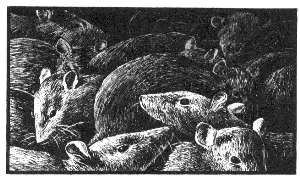 Army Rats
Army Rats
| TYPE: NUMBER: MOVE: IM/RS: STAMINA: ATTACK: DAMAGE: SPECIAL ATTACK: SPECIAL DEFENSE: NATIVE WORLD: | Small Carnivore 2-20 per character; 1,000 or more in a pack Fast (90 meters/turn) 6/60 5 40 1d5 bite + disease None None Volturnus - mountains |
DESCRIPTION: Army rats are furry brown creatures that resemble large rats. They have powerful hind legs and can leap up to 1 meter to attack. Army rats swarm in packs of 1,000 or more, and will attack any animal in their path. They are cunning and attack in waves, some sprinting after prey while others follow at a loping stride. When one wave of sprinters falters, another wave takes their place until the prey finally tires. A medium-sized creature caught by a swarm will be attacked by 2-20 army rats, while the rest pass by seeking other food.
Any creature bitten by an army rat has a 50% chance of being infected by a disease that attacks the central nervous system. A creature only needs to roll once per encounter with army rats. Unless a victim is given a dose of Antibody Plus within 12 hours, he will become hostile and paranoid and might even attack or desert his companions. Every 20 hours aher being bitten the victim can make a Stamina check. If the character succeeds, he has recovered. If not, another 20 hours must pass before the victim can try again.
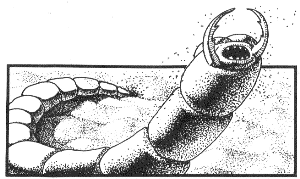 Funnel Worm
Funnel Worm
| TYPE: NUMBER: MOVE: IM/RS: STAMINA: ATTACK: DAMAGE: SPECIAL ATTACK: SPECIAL DEFENSE: NATIVE WORLD: | Giant Carnivore 1 Slow 4/35 200 45 (on surface) 3d10 bite Automatic hit if prey falls in funnel Will not be noticed unless it attacks Volturnus - desert |
DESCRIPTION: The funnel worm is a burrowing creature 5 to 7 meters long, with a segmented body and two large compound eyes which are also pressure-sensing organs. It has a pair of large mandibles and its mouth is filled with a ring of sharp teeth.
Funnel worms are solitary creatures. They lurk 5 to 10 meters beneath the surface waiting for preyto pass overhead. When it senses the vibrations of a creature passing, it quickly expands its body, swallowing the sand and forming a 1 0-meter-wide funnel of sand. The prey slides down the funnel into the worm's mouth. Any creature caught in the funnel must make a Reaction Speed check to leap aside. If the check is failed the creature will slide down the funnel and into the funnel worm's mouth in 2 turns. The funnel worm can automatically bite anything that falls into its mouth, causing 3d10 points of damage per turn to each victim until it dies. A funnel worm's mouth is wide enough to hold and bite up to three medium-sized creatures at once. Characters can be rescued if someone throws them a rope and pulls them out.
While in its burrow, a funnel worm can not be attacked by most weapons. Grenades and explosives are the most effective means of attack. They hit automatically when rolled down the funnel, but cause only half damage. The funnel worm will burrow to the surface and attack if it is wounded. A funnel worm's Attack score is 45 when out of its burrow.
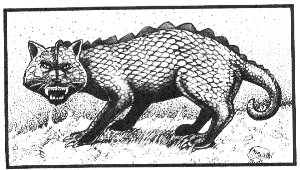 Megasaurus
Megasaurus
| TYPE: NUMBER: MOVE: IM/RS: STAMINA: ATTACK: DAMAGE: SPECIAL ATTACK: SPECIAL DEFENSE: NATIVE WORLD: | Giant Carnivore 1 Fast (90 meters/turn) 5/45 350 50 7d10 bite and claws None None Volturnus - dry plains, swamp |
DESCRIPTION: A megasaurus is 10 meters long and stands 5 meters high at the shoulders. It looks like a giant reptilian cat with a thick tail. It has huge claws and a massive mouth filled with sharp teeth, and can leap up to 50 meters to attack.
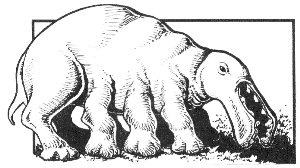 Land Whale
Land Whale
| TYPE: NUMBER: MOVE: IM/RS: STAMINA: ATTACK: DAMAGE: SPECIAL ATTACK: SPECIAL DEFENSE: NATIVE WORLD: | Giant Omnivore 1 Medium 3/25 300 65 1d10 bite A successful bite will swallow prey; a swallowed victim cannot attack None Volturnus - dry plains |
DESCRIPTION: A land whale looks like a 10-meter-long whale with eight short legs. Its jaws are hinged sideways. A land whale will swallow anything in its path, moving untiI its large mouth is full before stopping to digest the food. Land whales travel alone. They can move swiftly, but start slowly. They can start moving at a speed of 10 meters/turn, and can accelerate 10 meters/turn until they reach their top speed of 60 meters/turn.
A character bitten by a land whale must roll his Reaction Speed or less to avoid being swallowed. A swallowed character will automatically take 1d10 points of damage each turn until cut out of the land whale.
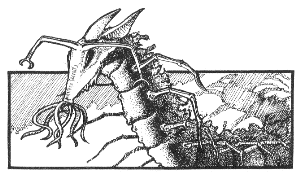 Slither (Sathar Attack Monster)
Slither (Sathar Attack Monster)
| TYPE: NUMBER: MOVE: IM/RS: STAMINA: ATTACK: DAMAGE: SPECIAL ATTACK: SPECIAL DEFENSE: NATIVE WORLD: | Giant Carnivore 1 Slow (10 meters/turn) 5/45 400 30 6d10 tentacles and bite Camouflage may surprise victims Can attack two creatures at once None None - salt flats and near water |
DESCRIPTION: A slither is 20 meters long and 2 meters wide. It resembles a giant-sized cross between a worm and a centipede. It is part plant and part animal; plants grow from its back, providing camouflage and some nourishment from photosynthesis. It can onIy see moving objects, but can sense salt and water. One ohen lurks near pools of water or salt licks, waiting for prey.
When Iying still, a Slither is often mistaken for a mound of plants, allowing it to attack with surprise. Its gnashing, grinding mandibles are surrounded by 2-meter-long tentacles. Slithers also secrete an oily fluid that causes burns on touch. They attack by lashing out with their tentacles, by biting with their jaws and by coiling around prey and burning it with their secretions. They must re-coil and make a new attack roll each turn to coil about prey. A slither can attack two creatures on the same turn, one with its tentacles and bite and the other by coiling around it. This makes them very deadly in combat.
Slithers are Sathar attack monsters. The Sathar, in their efforts to destroy peaceful worlds, have genetically altered a number of creatures into "monsters" which they set free on various worlds. Slithers and other Sathar attack monsters can be encountered on many different planets.
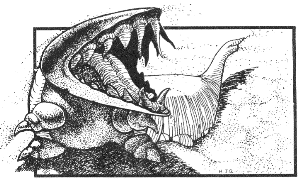 Sand Shark
Sand Shark
| TYPE: NUMBER: MOVE: IM/RS: STAMINA: ATTACK: DAMAGE: SPECIAL ATTACK: SPECIAL DEFENSE: NATIVE WORLD: | Giant Carnivore 1-2 Medium 5/50 80 50 2d10 bite None Immune to needler weapons Has hard cover when attacking from burrow Volturnus - deserts |
DESCRIPTION: The sand shark is a burrowing creature. It is 3 meters long, has a wedge-shaped head, thick, abrasive, leathery hide and twelve pairs of short legs. A sand shark has no eyes; it detects things by vibration, and smells through two rows of sensory organs and two sensory pits in the head. A sand shark burrows just beneath the surface of the sand, Ieaving a telltale ripple in its wake. Only explosives will affect it when it is beneath the sand, and they cause only half-damage. It reveals itself when it erupts at the feet of its target to attack. It attacks by biting. Its large mouth is filled with three rows of jagged teeth.
The sand shark can cross rocky areas by slithering across the surface, but its movement rate is reduced to Slow.
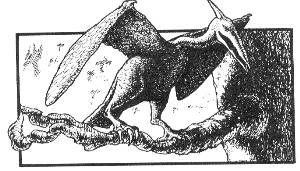 Winged Rippers
Winged Rippers
| TYPE: NUMBER: MOVE: IM/RS: STAMINA: ATTACK: DAMAGE: SPECIAL ATTACK: SPECIAL DEFENSE: NATIVE WORLD: | Small Carnivore 4-40 Fast 6/55 30 60 1d5 beak None None Volturnus - all terrains |
DESCRIPTION: Winged rippers are scavenger birds that gather in great numbers around any carrion. A ripper looks like a cross between a vulture and a humming bird. Their brownish-gray feathers look tattered, and have a distinct odor of decay. Winged rippers are impatient and may attack small animals or sick or injured creatures. A large number of winged rippers (more than 20) may attack healthy creatures of man-size or larger. When they attack, the entire flock swoops at the intended victim. As they pass, 1d10 of the creatures will slash with their razor-sharp beaks. Winged rippers are basically cowardly, however, and if more than one-tenth of the flock is killed, all the rest will flee.
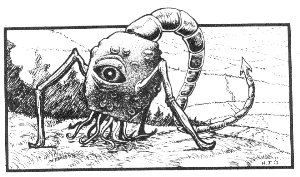 Queequeg
Queequeg
| TYPE: NUMBER: MOVE: IM/RS: STAMINA: ATTACK: DAMAGE: SPECIAL ATTACK: SPECIAL DEFENSE: NATIVE WORLD: | Large Carnivore 1-5 Fast (90 meters/turn) 6/60 180 50 3d10 harpoon Harpoon can strike victim up to 5 meters away Chitinous exoskeleton acts as skeinsuit, reducing damage from non-energy attacks by half Volturnus - forest |
DESCRIPTION: Queequegs have barrel-shaped bodies with three jointed legs arranged like a tripod, and three eyes spaced evenly around the body so it can see all directions at once. They have a hard exoskeleton that matches the color of the plants where they live, providing a natural camouflage. Its mouth is in its underbelly, surrounded bysmall tentacles. Asingle 5-meter-longtentaclegrowstrom the top of the body. The long tentacle tapers to a point with a razor-sharp barb.
The queequeg attacks by whipping this tentacle at its prey like a harpoon. Once the tentacle hits a target the sharp barb makes it difficult to pull out. The queequeg then pulls the victim to its mouth in one turn, and holds the prey with the filaments while devouring it. A character that is being eaten automatically takes 2d10 points of damage each turn until rescued. The victim can not fight back once he is held in the small tentacles. If characters attack the harpoon tentacle and cause 20 points of damage, the tentacle is severed.
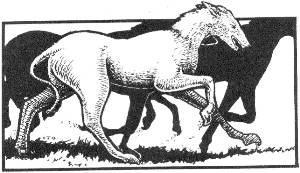 Tomar's Horses
Tomar's Horses
| TYPE: NUMBER: MOVE: IM/RS: STAMINA: ATTACK: DAMAGE: SPECIAL ATTACK: SPECIAL DEFENSE: NATIVE WORLD: | Large Omnivore 1-100 Fast (90 meters/turn) (25 km/hour) 6/60 120 40 3d10 bite and hooves Stampede Attack score 70, 8d10 damage None Volturnus - dry plains |
DESCRIPTION: Tomar's horses look like a cross between a horse and a jackal. They stand 1.6 meters tall at the shoulder and weigh about 400 kilograms. Tomar's horses eat seeds, nuts, grains, berries and meat. They will eat carrion, but prefer fresh meat.
Tomar's horses are cunning. They may stalk their prey, taking advantage of cover to hide their approach. They try to herd their prey into traps so it can not escape. Individual Tomar's horses attack by pawing with their hooked hooves and biting.
A herd of Tomar's horses can attack by stampeding and trampling its prey. When a hungry herd sights prey it will charge the creatures and attempt to trample them. Their Attack score for a stampede attack is 70. Characters are safe from a stampede if they find hard cover to hide behind. If no cover is available, the character can try to stun or kill one of the lead animals and hide behind its body. There is a 75% chance the herd will charge again if the prey survived the first stampede. If more than one horse was killed in a stampede, there is only a 25% chance they will attack again. A trampled character takes 8d10 points of damage.